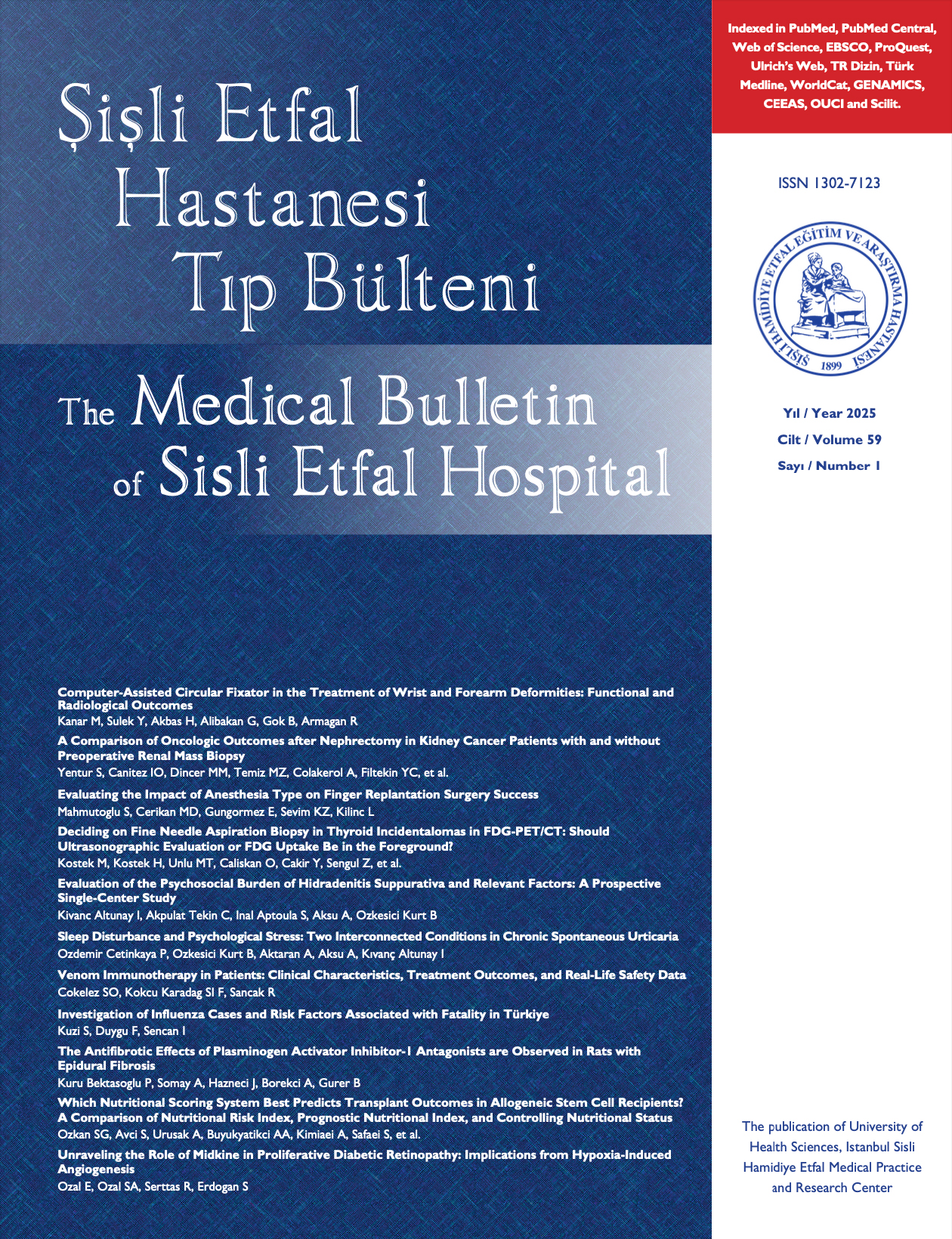
Management of Thyroid Nodules
Mehmet Uludag1, Mehmet Taner Unlu1, Mehmet Kostek1, Nurcihan Aygun1, Ozan Caliskan1, Alper Ozel2, Adnan Isgor31Division of Endocrine Surgery, Department of General Surgery, University of Health Sciences Türkiye, Sisli Hamidiye Etfal Training and Research Hospital, Istanbul, Türkiye2Department of Radiology, University of Health Sciences Türkiye, Sisli Hamidiye Etfal Training and Research Hospital, Istanbul, Türkiye
3Department of General Surgery, Sisli Memorial Hospital, Istanbul, Türkiye
Thyroid nodules are common and the prevalence varies between 4 and 7% by palpation and 1968% by high-resolution USG. Most thyroid nodules are benign, and the malignancy rate varies between 7 and 15% of patients. Thyroid nodules are detected incidentally during clinical examination or, more often, during imaging studies performed for another reason. All detected thyroid nodules should be evaluated clinically. The main test in evaluating thyroid function is thyroid stimulating hormone (TSH). If the serum TSH level is below the normal reference range, a radionuclide thyroid scan should be performed to determine whether the nodule is hyperfunctioning. If the serum TSH level is normal or high, ultrasonography (US) should be performed to evaluate the nodule. US is the most sensitive imaging method in the evaluation of thyroid nodules. Computed tomography (CT) and magnetic resonance imaging are not routinely used in the initial evaluation of thyroid nodules. There are many risk classification systems according to the USG characteristics of thyroid nodules, and the most widely used in clinical practice are the American Thyroid Association guideline and the American College of Radiology Thyroid Imaging Reporting and Data System. Fine needle aspiration biopsy (FNAB) is the gold standard method in the evaluation of nodules with indication according to USG risk class. In the cytological evaluation of FNAB, the Bethesda System for Reporting Thyroid Cytopathology (TBSRTC) is the most frequently applied cytological classification. TBSRTC is a simplified, 6-category reporting system and was updated in 2023. The application of molecular tests to FNAB specimens, especially those diagnosed with Bethesda III and IV, is increasing to reduce the need for diagnostic surgery. Especially in Bethesda III and IV nodules, different methods are applied in the treatment of nodules according to the malignancy risk of each category, these are follow-up, surgical treatment, radioactive iodine treatment, and non-surgical ablation methods.
Keywords: Imaging, risk classification, thyroid nodule, treatment managementTiroid Nodüllerine Yaklaşım
Mehmet Uludag1, Mehmet Taner Unlu1, Mehmet Kostek1, Nurcihan Aygun1, Ozan Caliskan1, Alper Ozel2, Adnan Isgor31Türkiye Sağlık Bilimleri Üniversitesi, Şişli Hamidiye Etfal Eğitim ve Araştırma Hastanesi, Genel Cerrahi Kliniği, İstanbul2Türkiye Sağlık Bilimleri Üniversitesi, Şişli Hamidiye Etfal Eğitim ve Araştırma Hastanesi, Radyoloji Kliniği, İstanbul
3Şişli Memorial Hastanesi, Genel Cerrahi Kliniği, İstanbul
Tiroid nodülleri sık olup, prevalans palpasyonla %4-7, yüksek çözünürlüklü USG ile %19-68 arasında değişmektedir. Tiroid nodüllerinin çoğu benignd olup malinite oranı hasta %7-15 arasında değişmektedir. Tiroid nodülleri klinik muayene veya daha sıklıkla başka bir nedenle yapılan görüntüleme yöntemlerinde insidental olarak saptanmaktadır. Saptanmış olan tüm tiroid nodülleri klinik olarak değerlendirilmelidir. Tiroid fonksiyonunun değerlendirlmesinde temel test TSHdır. Serum TSH düzeyi normal referans aralığının altındaysa, nodülün hiperfonksiyonel olup olmadığını belirlemek için bir radyonüklid tiroid taraması yapılmalıdır. Serum TSH düzeyi normal veya yüksekse nodüllü değerlendirmek için ultrasonografi (US) yapılmalıdır. US tiroid nodüllerinin değerlendirilmesinde en sensitif görüntüleme yöntemidir. Bigisayarlı tomografi (BT) ve magnetik rezonans görüntüleme (MRG)ın tiroid nodüllerinin ilk değerlendirmesinde rutin kullanılmazlar Tiroid nodüllerinin USG özelliklerine göre birçok risk sınıflama sistemi mevcut olup, klinik pratikte en yaygın kullanılan Amerikan Tiroid Birliği (ATA) klavuzu ve Amerikan Radyoloji Koleji Tiroid Görüntüleme Raporlama ve Veri Sistemi (ACR TI-RADS)dır. USG risk sınıfına göre endikasyonu olan nodüllerin değerlendirmesinde ince iğne aspirasyon biyopsisi (İİAB) altın standart yöntemdir. İİABnin sitolojik değerlendirmesinde Bethesda Tiroid Sitopatolojisini Raporlama Sistemi (TBSRTC) en sık uygulanan sitolojik sınıflamadır. TBSRTC basitleştirilmiş, 6 kategoriye dayalı bir raporlama sistemi olup, 2023 yılında güncellenmiştir. Özellikle Bethesda III ve IV tanılı İİAB örneklerine tanısal cerrahi girişim ihtiyacını azaltmak için moleküler testlerin uygulanması giderek artmaktadır. Özellikle tanı koyulamaya Bethesda III ve IV nodüllerde Her kategorinin malinite riskine göre nodüllerin tedavisinde farklı yöntemler uygulanmakta olup, bunlar; takip, cerrahi tedavi, radyoaktif iyot tedavisi, cerrahi dışı ablasyon yöntemleridir. (SETB-2023-09-176)
Anahtar Kelimeler: Görüntüleme, risk sınıflaması, tiroid nodülü, tedavi yönetimiManuscript Language: English



















